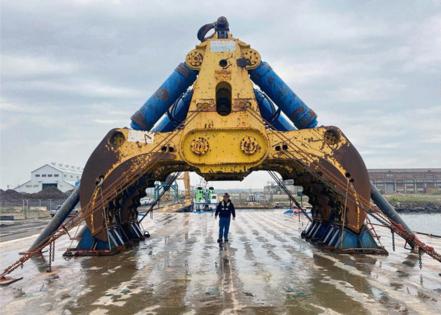Key Bridge collapse: Massive claw to clear remaining debris; deeper channel to open Thursday
Published in News & Features
BALTIMORE — Giant crane, meet giant claw.
A massive hydraulic grab arrived in Baltimore over the weekend as officials plan a new phase of efforts to clear the debris of the Francis Scott Key Bridge to commence after a planned Thursday opening of the deepest alternate channel through the wreckage yet.
The grab will be attached to the Chesapeake 1000 crane and work as a “vital part” of debris-removal operations at the bottom of the Patapsco River in the next stage of operations, said Coast Guard Petty Officer Michael Himes, a spokesperson for the Key Bridge Response Unified Command. The set of four hydraulic claws weighs 165 metric tons when empty and can hold up to 1,000 metric tons, according to its Dutch manufacturer, The Grab Specialist.
The grab comes as a 35-foot channel is expected to open, allowing larger vessels to travel into the Baltimore harbor and salvage operations start to pivot toward clearing debris from the harbor’s 50-foot main channel. The new alternate channel will be the deepest of the temporary routes into the harbor and the Port of Baltimore, which has been blocked to most vessel traffic since the cargo ship Dali struck a bridge support column March 26, causing the 1.6-mile bridge to collapse and killing six construction workers.
The Fort McHenry Limited Access Channel is planned to open to commercially essential vessels from Thursday until 6 a.m. next Monday, according to a marine safety bulletin issued Monday evening by the Coast Guard, which noted that weather could impact the schedule. Vessels hoping to transit the new channel, which runs close to the still-immobile Dali, will have to request access and be approved based on their size and other factors. Deeper-draft vessels will need to be helmed by a Maryland pilot and escorted by two tugboats.
After Monday morning, the temporary channel is set to remain closed until at least May 10, as the “critical and highly dynamic salvage operations” to fully clear the channel begin at the start of next week.
The footprint of salvage operations in the water will have to change to accommodate the colossal size of the hydraulic grab when it moves in for subsurface debris removal, Himes said. He recalled the grab being on standby — but not used due to size constraints — when he worked in the public information office during the salvage operations on the Golden Ray, a Baltimore-bound cargo ship that capsized off the Georgia coast. This time around, the grab is going to get work.
The hydraulic grab was built in 2015 in its manufacturer’s factory in the Netherlands and is the only one in the world of its size with four independent hydraulic claws, the company’s managing director, Emiel Bleyenberg, said in an email. Soon after it was built, the grab was used by the global salvage firm Ardent to clear wreckage from the Troll Solution, a jack-up offshore oil rig that collapsed in 2015.
______
©2024 The Baltimore Sun. Visit at baltimoresun.com. Distributed by Tribune Content Agency, LLC.







Comments